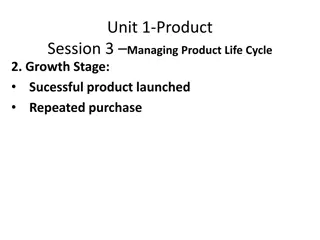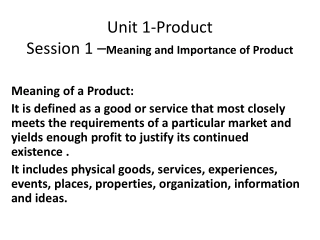Understanding Global Product Development and Adaptation Strategies
Global product development involves creating products that can succeed in various countries, considering factors like cultural norms and regulations. Product adaptation is crucial for businesses to tailor products to meet local customers' needs and comply with laws, helping them compete effectively in international markets.
Download Presentation
Please find below an Image/Link to download the presentation.
The content on the website is provided AS IS for your information and personal use only. It may not be sold, licensed, or shared on other websites without obtaining consent from the author. Download presentation by click this link. If you encounter any issues during the download, it is possible that the publisher has removed the file from their server.
Presentation Transcript
GLOBAL PRODUCT Global internationally under the same brand name, features and specifications across countries. Global products are different from regional products or brands, which are specific to a particular region. products are those products that are marketed
What is Global Product What is Global Product Development? Development? Global product development is a phenomenon impacting more businesses in the modern age. It involves creating new products that can function well in various countries worldwide. Global product development is effectively an extension of globalization, which in business refers to a company's ability to operate well on an international scale. Businesses need to learn to adapt their products and marketing to suit people's needs in various parts of the world. A product that can successfully do this is considered a global product. There are several factors to consider when developing a global product. These include the target country's culture and norms, current demand in various parts of the world, and the regulations and laws guiding the production and sale of the product in question.
Product adaptation Product adaptation is the process by which businesses change their products with the aim of selling them to foreign markets. Product adaptation is done since customers in different regions have differing values, preferences, beliefs, cultures, and needs. Therefore, product adaptation aims mainly to serve local customers' specific needs. Another major purpose is to comply with the set laws and regulations. Although the products are modified, their core purpose or benefit is retained
A product adaptation model can be characterized by its components. These include: Customer research: When making alterations, a business needs to get opinions from the target customers about their needs and preferences. Export research: When targeting foreign markets, businesses should research in detail the cost and time taken to adapt the product to suit the market's needs. They should also consider factors such as customer service, prices, preferences, and the prevailing regulations.
Competition: When dealing with intense competition, it is critical to evaluate the features of competitor products that are superior. Instead of introducing new products, a business can respond to competition by adding superior product features. This will prevent them from losing their market share.
Product standardization closely resembles product adaptation, since both deal with producing and selling goods in a foreign market. However, the two are different in various aspects, as follows. Product adaptation entails modifying an existing product to make it more suitable for a new market. In contrast, product standardization deals with making products in all markets uniform. In product adaptation, the cost of production is high since different materials are required in production. In contrast, the production cost is lower in product standardization since similar materials are required to produce the goods.
Businesses that engage in product adaptation give their consumers different options. In contrast, product standardization gives consumers only one product option. Product standardization makes production more efficient since only one product is made. In contrast, product adaptation hampers efficiency since products have to be modified to suit different consumers. Businesses can choose to standardize their products to make them easier to produce and lower the cost of production. Similarly, they may decide to modify them to serve diverse customers.

















































